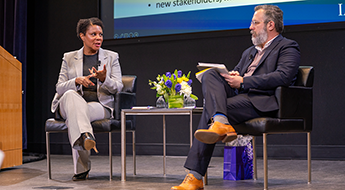New IPR Research: September 2023
Get all our news

This month’s new research from IPR faculty investigates early-life psychological stress and long-term health effects, the incarceration rates of immigrants and U.S.-born men, and public perceptions of Black girls and their punitive consequences. It also examines improving communication of education research, whether joint bank accounts can improve marriage quality, and researching the psychology of racial bias using a bidirectional approach.
Social Disparities and Health
Early-Life Psychological Stress and Long-Term Health Effects
Inflammation is thought to be a key pathway linking childhood stress with health problems, yet the available research has not been comprehensively evaluated to further understand this relationship. In Psychological Bulletin, IPR health psychologists Edith Chen and Greg Miller, graduate research assistant Phoebe Lam, and former IPR post-doctoral fellow Jessica Chiang of Georgetown University seek to answer three questions: How the relationship between childhood stress and inflammation changes over the lifespan, if certain childhood stressors affect inflammation differently, and which inflammation components are associated with childhood stress. Their meta-analysis examined 187 studies from the last two decades that investigated the relationship between childhood stress and inflammation. The researchers find that as people age, the relationship between childhood stress and inflammation gets stronger, suggesting that effects of early stress grow over time. They also find that children exposed to severe or chronic psychological stress, such as living in a violent neighborhood or having a clinically depressed parent, had higher levels of inflammation. The meta-analysis found that different components of inflammation are similarly associated with stress. These findings better establish the link between inflammation and stress-induced health issues and identify inflammation as a key target to relieve childhood stress effects. These findings can help determine what interventions, especially psychological ones, to provide, who might benefit from them, and if certain stressful experiences should be addressed. Edith Chen is the John D. and Catherine T. MacArthur Professor of Psychology and Greg Miller is the Louis W. Menk Professor of Psychology.
Politics, Institutions, and Public Policy
Incarceration Rates of Immigrants and U.S. Men, 1870–2020
Anti-immigrant sentiment in the U.S. has long associated immigrants with criminality. In a recent working paper, IPR economist Elisa Jácome and her colleagues delve into 150 years of records to see what the data say: Were immigrants ever more likely to commit crimes than those born in the U.S.? Are today’s immigrants more likely to be criminals than earlier ones? To investigate, the researchers used Census data from 1870–1940, as well as nationally representative samples from 1950–2020. To measure criminality, the authors identify men in prison in these data. Their data show that for the last 150 years, incarceration rates for immigrants were lower than U.S.-born men. Since 1960, the gap between the two groups has widened. Today, immigrants are 60% less likely to be incarcerated than all U.S.-born men and 30% less likely to be incarcerated than White U.S.-born men. The decline in the rate of immigrants going to prison, compared to the U.S. born, holds for immigrants from all regions. The researchers argue that changes in criminal justice and immigration policies cannot explain today’s larger incarceration gap. They suggest, rather, that it results from structural economic forces disproportionately affecting low-educated U.S.-born men over the last five decades.
Public Perceptions of Black Girls and Their Punitive Consequences
 Despite data on the disproportionate levels of punishment Black girls face, there is little political science research investigating the public attitudes that enables this treatment. In the Journal of Race, Ethnicity, and Politics, IPR social policy expert Sally Nuamah and social policy scholar and IPR associate Quinn Mulroy study how public perceptions of Black girls shape support for their punishment. In a March 2020 survey experiment, the researchers presented 1,466 adults with a scenario where a student violated the school’s dress code policy. Four names commonly described in research as stereotypical of particular racial and gender groups—Keisha (Black girl), Emily (White girl) Jamal (Black boy), and Jake (White boy)—were randomly presented as the violator. The participants were asked a series of questions about their perception of the student. The researchers replicated the study in October 2020 with 2,266 adults. The first study’s findings show Emily and Keisha were perceived as older than the male students, but Keisha was viewed as significantly more dangerous and experienced with sex. The findings of the second study, conducted after the racial justice protests in 2020, show Keisha was perceived as older than the other students—a finding they define as indicative of their adultification—and Keisha and Jamal were both perceived as more dangerous. They also find that this adultification led to support for harsher punishments and punitive policies for Black girls across the two studies. This evidence demonstrates the link between negative stereotypes about Black girls’ maturity and support for harsher punishment in schools and beyond, highlighting the potential role of the American public in contributing to uneven punitive experiences.
Despite data on the disproportionate levels of punishment Black girls face, there is little political science research investigating the public attitudes that enables this treatment. In the Journal of Race, Ethnicity, and Politics, IPR social policy expert Sally Nuamah and social policy scholar and IPR associate Quinn Mulroy study how public perceptions of Black girls shape support for their punishment. In a March 2020 survey experiment, the researchers presented 1,466 adults with a scenario where a student violated the school’s dress code policy. Four names commonly described in research as stereotypical of particular racial and gender groups—Keisha (Black girl), Emily (White girl) Jamal (Black boy), and Jake (White boy)—were randomly presented as the violator. The participants were asked a series of questions about their perception of the student. The researchers replicated the study in October 2020 with 2,266 adults. The first study’s findings show Emily and Keisha were perceived as older than the male students, but Keisha was viewed as significantly more dangerous and experienced with sex. The findings of the second study, conducted after the racial justice protests in 2020, show Keisha was perceived as older than the other students—a finding they define as indicative of their adultification—and Keisha and Jamal were both perceived as more dangerous. They also find that this adultification led to support for harsher punishments and punitive policies for Black girls across the two studies. This evidence demonstrates the link between negative stereotypes about Black girls’ maturity and support for harsher punishment in schools and beyond, highlighting the potential role of the American public in contributing to uneven punitive experiences.
Education Policy
Improving Communication of Education Research
Over the last 20 years, education research has focused on conducting high-quality causal studies to help school decision makers implement the best interventions, curricula, and practices and communicating them through mechanisms such as the Institute of Educations Sciences’ What Works Clearinghouse. In a 2022 report, the National Academies of Sciences, Engineering, and Medicine (NASEM) recommended a new type of research, “Knowledge Mobilization,” to study the connections between education research and schools. IPR statistician Elizabeth Tipton participated in the committee that developed NASEM recommendations, and she and former IPR graduate research assistant Kaitlyn Fitzgerald, now at Azusa Pacific University, present a three-part framework for the new field in the Journal of Research on Educational Effectiveness. Using their own field of statistical research as an example, they ask, “How should statistical evidence be reported and conveyed to facilitate evidence-based decision making by education practitioners and policymakers?” The three facets of the framework are (1) normative, examining the norms researchers assume and embed in their findings; (2) descriptive, understanding how educators and policymakers reason about evidence; and (3) prescriptive, developing and evaluating communication to enable decision makers to better use evidence. Fitzgerald and Tipton emphasize the disconnect between the message researchers send and what decision makers receive, which is also influenced by their outlook and understanding, as well as the particular situation. The researchers argue for creating an integrated science that focuses on translating and disseminating scientific findings incorporating data visualization and human-computer interaction.
Child, Adolescent & Family Studies
Can Joint Bank Accounts Improve Marriage Quality?
 Organizing finances is an important step for newlyweds, and it may set the tone for the rest of their marriage. In the Journal of Consumer Research, IPR social psychologist Eli Finkel and his colleagues investigate whether combining money into a joint account improves relationship quality across two studies. In the first study, the researchers conducted a two-year experiment with 230 male-female couples who had separate bank accounts and were engaged or newly married. They instructed 96 couples to merge their accounts, 66 couples to keep their accounts separate, and 68 couples to maintain any account structure they liked. In a second study, 507 married individuals were surveyed about their banking habits, financial harmony, communality, and alignment of financial goals within their marriages. During the first year of the first study, the researchers surveyed each partner individually once every three months and again at the end of the study. They measured the couple's satisfaction, conflict tactics, and how well they interacted to determine their relationship quality. To better understand the couple's financial harmony, the research team asked each partner how much they agreed with statements about financial habits in their marriage. In both studies, couples who combined money in a joint account maintained their relationship quality and increased financial harmony. The results provide causal evidence that joint accounts preserve relationship quality in the first few years of marriage, a critical period when the dynamics that couples develop predict how their relationship will progress.
Organizing finances is an important step for newlyweds, and it may set the tone for the rest of their marriage. In the Journal of Consumer Research, IPR social psychologist Eli Finkel and his colleagues investigate whether combining money into a joint account improves relationship quality across two studies. In the first study, the researchers conducted a two-year experiment with 230 male-female couples who had separate bank accounts and were engaged or newly married. They instructed 96 couples to merge their accounts, 66 couples to keep their accounts separate, and 68 couples to maintain any account structure they liked. In a second study, 507 married individuals were surveyed about their banking habits, financial harmony, communality, and alignment of financial goals within their marriages. During the first year of the first study, the researchers surveyed each partner individually once every three months and again at the end of the study. They measured the couple's satisfaction, conflict tactics, and how well they interacted to determine their relationship quality. To better understand the couple's financial harmony, the research team asked each partner how much they agreed with statements about financial habits in their marriage. In both studies, couples who combined money in a joint account maintained their relationship quality and increased financial harmony. The results provide causal evidence that joint accounts preserve relationship quality in the first few years of marriage, a critical period when the dynamics that couples develop predict how their relationship will progress.
Poverty, Race & Inequality
Researching the Psychology of Racial Bias Using a Bidirectional Approach
The field of psychology often focuses on the study of racial bias through the lens of the individual, yet this approach largely ignores systemic racism and the way bias is shaped by broader cultural systems. In Nature Reviews Psychology, IPR psychologist Sylvia Perry and her colleagues examine the bidirectional relationship between individual-level biases and systems and structures that create and reinforce racial inequality. The researchers examine five systemic factors that relate to the individual level: power and privilege disparities, cultural narratives and values, segregated communities, shared stereotypes, and nonverbal messages. For example, when it comes to systems around cultural narratives and values, American history is often taught through a White-affirming lens in schools, obscuring the relationship between contemporary systemic injustice and racial injustices of the past. This can shape individual attitudes about race and racism. Individual-level bias can also impact how history and culture are presented, based on how an educator selects and constructs narratives. This example highlights the way systemic and individual level biases influence and play into one another. The researchers propose several intervention recommendations to reduce racial bias, including for White parents to talk to their children about race and racism and better education about the history and systems that have led to current racial injustices and inequalities. Future psychology research should test interventions to reduce racial bias that targets both systems and individuals.
Photo credits: Unsplash
Published: September 21, 2023.


